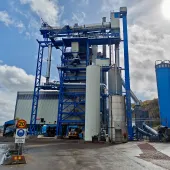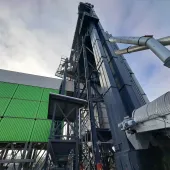Assessing Odour from Asphalt Plants

First published in the February 2018 issue of Quarry Management
Ayan Chakravartty and Daniel Quinn of DustScanAQ describe the steps they follow when assessing asphalt plant odours
The most obvious potential odour impact in the quarrying sector is from asphalt plants. This article outlines the steps that may be used to prepare an assessment of the possible odour impacts on sensitive receptors during the operational phase of an asphalt plant. In the UK, odour assessment is primarily based on two key documents from the Institute of Air Quality Management (IAQM), ‘Guidance on the assessment of odour for planning’ (2014), and from the Environment Agency (EA), ‘H4 Odour Management Guidance’ (2011). The necessary steps in data collection and analysis are summarized below to demonstrate how odour impacts are considered as part of a planning or environmental permitting regime.
As with other dust and air-quality concerns, an odour assessment is based on the source-pathway-receptor approach. In the case of asphalt plants, the source is significant as bitumen fumes may contain poly-aromatic hydrocarbons (PAHs) and volatile organic compounds (VOCs). In most cases the principal source will be the controlled emissions from the plant’s stack. The constraints on emissions include a number of plant parameters such as location, temperature, pressure, stack diameter and height, exit velocity, aggregate moisture content, the efficacy of arrestment items, plant load/capacity, and operating hours. The proportion and types of recycled aggregates used may also influence odour levels. Uncontrolled emissions may result from a variety of on-site processes, including process venting and loading into tipper trucks, and are not usually included in these assessments unless their contribution is considered significant.
The procedure of combining a number of assessment tools within an odour assessment is a feature that often distinguishes odour-related studies from conventional air-quality assessments. Usually an odour assessment includes both qualitative and quantitative assessments of odour impact, in order to compare the results and arrive at a finding with greater confidence. Examples of both are given for a site that has recently been assessed as part of an ongoing planning and environmental permitting process.
Qualitative assessment
To estimate the odour-generating potential of a plant it is necessary to consider the scale of the odour release (magnitude), how inherently odorous the emission is, and the relative pleasantness/unpleasantness of the odour (its hedonic tone). Guidance on this is given in the IAQM document, since it depends on a combination of professional judgements and may include matters such as ‘sniff tests’.
A detailed knowledge of the site and relevant asphalt production processes is required, and the source odour potential is categorized as small, medium or large. A typical quarry asphalt plant is often near to other structures with open land beyond and some housing at a distance.
The risk of odour exposure by the receptor is evaluated by combining the source odour potential and the dilution along the pathway using the IAQM methods and considering the sensitivity of individual receptors and the total number of receptors that may be affected. The impact of odours on different receptors may be ranked as negligible, slight adverse, moderate adverse or substantial adverse. Where the overall effect is greater than slight adverse the impact is likely to be considered significant and potentially unacceptable.
It is necessary to assess the extent of dispersion and dilution of an odour along the pathway between the source and the receptor – the pathway effectiveness. This, in turn, calls for a calibration of the frequency of winds blowing from the source in the direction of the receptors and a categorization of the pathway length. These two items are used in the assessment of the pathway effectiveness, as shown in Table 1. From this the likely effects at each receptor are estimated, as indicated in Table 2.
Quantitative assessment
These assessments rely upon examining the specific distribution of an odour as if it was any other form of gaseous emission and are carried out using dispersal-modelling software (most commonly ADMS or AERMOD). Hence, the computing methods call for a number of inputs, such as the locations of sources and receptors, the topography of the area, structures that might influence airflows, and meteorological information. The modelling used in the example dealt with by DustScanAQ was carried out using ADMS-5 (v5.2.2.0). This is a complex model that aims to incorporate data on layers within the atmosphere around and beyond the source, since these conditions which control dispersion are influenced by the immediate area; adjustments are made in accordance with whether the site is in a rural, suburban or urban area.
Odour standards have been established based on recognized laboratory methods; one odour unit is that concentration when 50% of professional assessors cannot detect an odour in one cubic metre of gas (ie 1OUE/m3). Practical experience of asphalt plants suggests that concentrations of 5OUE/m3 expressed as the 98th percentile of a one-hour average concentration do not generally cause a nuisance away from the source. Nevertheless, the EA has set a limit of 1.5 OUE/m3 for the most offensive odours, such as rotting fish or sewage. Asphalt odours are considered to be moderately offensive and on a par with fat frying and livestock odours.
Dispersion modelling requires a range of input data for the source, weather and location. The source data includes the 3D co-ordinates of the stack, its height and diameter, as well as the temperature and flow rate of emissions. The meteorological data needed include wind speeds and direction, surface temperature, cloud cover, precipitation and relative temperature. Assessments also have to be made of the stability of the atmosphere. This information is not readily collected by simple site weather stations and long-term Met Office data is generally required. The input of locational information typically includes suitable terrain data, details of buildings and structures within and near the source, and the characterization of the pathway topography (roughness of the ground surface).
In an odour assessment the relevant receptors and their location are important and, therefore, need to be considered carefully. There is a complex relationship between the odour at a receptor and the source that depends on items such as distance to the receptor, local topography, the weather conditions, especially wind speed and direction, but also air pressures and temperatures.
The computations that then take place are run to accommodate a number of modelled scenarios, for example using several years of weather data, a modelled area of adequate extent, a range of emission parameters, and operating conditions that consider a worst-case scenario and also address some of the known uncertainties associated with dispersion modelling.
Using this technique it is then possible to compute the distribution of the odour concentrations as a plan (fig. 1) or as a table (Table 3) with each receptor indicated.
Evaluation
The findings from the magnitude of odours at receptors based on the modelling are then compared with the empirical qualitative assessments. In addition, and in the future, these findings may also be compared with any routine or regular sniff testing, and used to investigate any complaints.
As may be seen in this example, neither method of assessment indicated a level of odour from the asphalt plant that was likely to be unacceptable. Using the qualitative approach the odours were slight to negligible in all cases; with the quantitative method the computed odour levels were all below 0.34 OUE/m3 and therefore considered to be negligible. In any assessment each site is unique and has to be considered in accordance with local conditions.
For more information visit: www.dustscan.co.uk
- Subscribe to Quarry Management, the monthly journal for the mineral products industry, to read articles before they appear on Agg-Net.com








